WHEN MIKE BARTICK GOES TO HIS 40-YEAR HIGH SCHOOL REUNION in a couple of years, he’ll have to explain how a Southern California kid ended up living mainly in the Philippines and becoming one of the world’s most innovative marine life photographers. His trajectory will be one of a kind for the class of ’85 — barely relatable, yet endlessly fascinating.
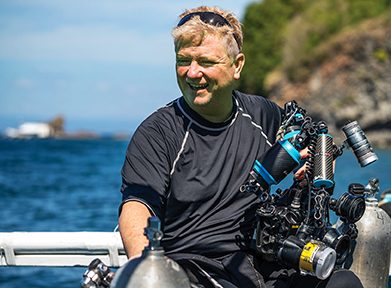
My buddy Tobias Friedrich snapped a photo of me while we were having fun and talking about the previous dive. I’m holding my simple macro kit: 105mm lens, strobes, diopter, and float arms. TOBIAS FRIEDRICH
The story will be about his dad, a Navy sailor in World War II who moved from Detroit, Michigan, to Westminster, California, to be closer to the ocean. Trips in the family car to Huntington Beach as a kid instilled in Mike a calling to the sea. These were different, perhaps less dangerous times, but when he was only 8 years old he’d hop on the bus to Huntington, where he would body surf and swim. As he got a little older, his bike was his passport to beach adventure, and he would snorkel around Laguna Beach and boogie board at the iconic surf break known as the Wedge.
He constantly searched the water for the coral reefs he saw in National Geographic, not knowing there was a difference between tropical and temperate habitats. When his family went to Hawai‘i for a summer vacation, he had his epiphany. Warm, clear waters were different — not necessarily better, as he loved his California backyard, but a world unlike what he knew. He tried to tell the tale with his Minolta Weathermatic 110 film camera to predictably miserable results.
Cousteau’s documentaries and Sea Hunt were before his time, but books and magazines depicting the underwater world captured his attention. For no apparent reason that his parents could ever deduce, he often walked around the house making the sound of exhaust bubbles. Mike contends that “whatever it is, it’s always been there.”
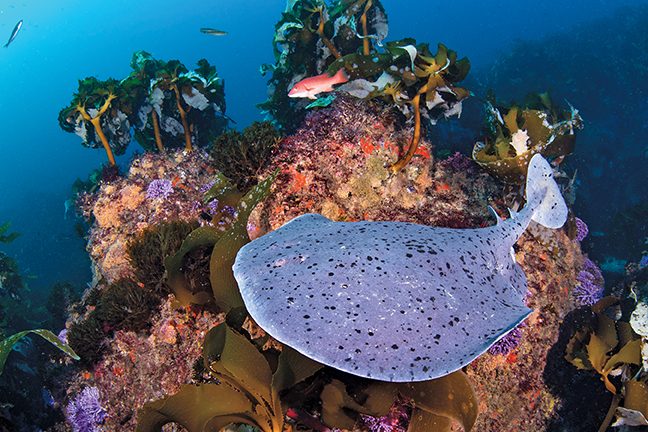
A confident electric torpedo ray hovers in the light current above a pinnacle at Farnsworth Banks. These torpedo rays and the purple hydrocorals make this remote dive spot popular. MIKE BARTICK
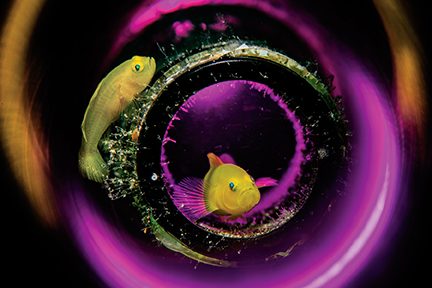
I enjoy combining different gadgets to create fun images. Like a secret ingredient in any recipe, the unique addition should accentuate but not overpower the main element. MIKE BARTICK
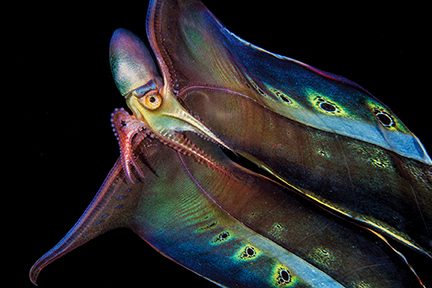
Nothing can prepare you for the alien beauty of a blanket octopus. In moments like this, I still hear my mentor’s voice shouting in my head: “Chance of a lifetime — don’t mess it up!” MIKE BARTICK
Whatever “it” was evolved slowly. For 20 years Mike had a career as a chef. It was so stressful that his friends told him he needed to do something to take the edge off, and one of their suggestions was to go to Catalina and try diving. Once underwater, an aura of peace enveloped him. He started going to Shaw’s Cove in Laguna Beach every day after work. When he found his first nudibranch, he thought he had discovered a new species. While that was not the case, he describes the experience as his “gateway drug.”
Seeking like-minded enthusiasts, he joined a dive club and wanted to share underwater photos. The $10,000 Nikon RS he coveted was beyond his grasp, but a 3-megapixel Sony digital was attainable, so he got his first digital camera. It didn’t have any strobes, but he didn’t know what they were for anyway. One of his early shots was of a bat ray swimming through the kelp. He showed it to his friends on the boat, one of whom passed it on to California Diving News. They ran it, so by 2004 he was a published underwater photographer.
In those early years, around 2005, Mike shot a lot of macro images. Captioning them meant improving his writing skills and researching more about his subjects. He started understanding that the best behavioral shots were from people who understood their subjects’ habits and habitats. To be a better photographer, he learned to be a better naturalist.
I know you primarily for your work from the Coral Triangle, particularly in the Philippines. How did your transition there from Southern California happen?
By 2006 I was already obsessed with photography, and I was making money as a chef, so I could afford to travel to new and exotic dive destinations to practice my craft. I went to Indonesia, and Lembeh was my first love. It was heaven for a critter enthusiast, and the thought consumed me that one day I could live somewhere like that and shoot every day.
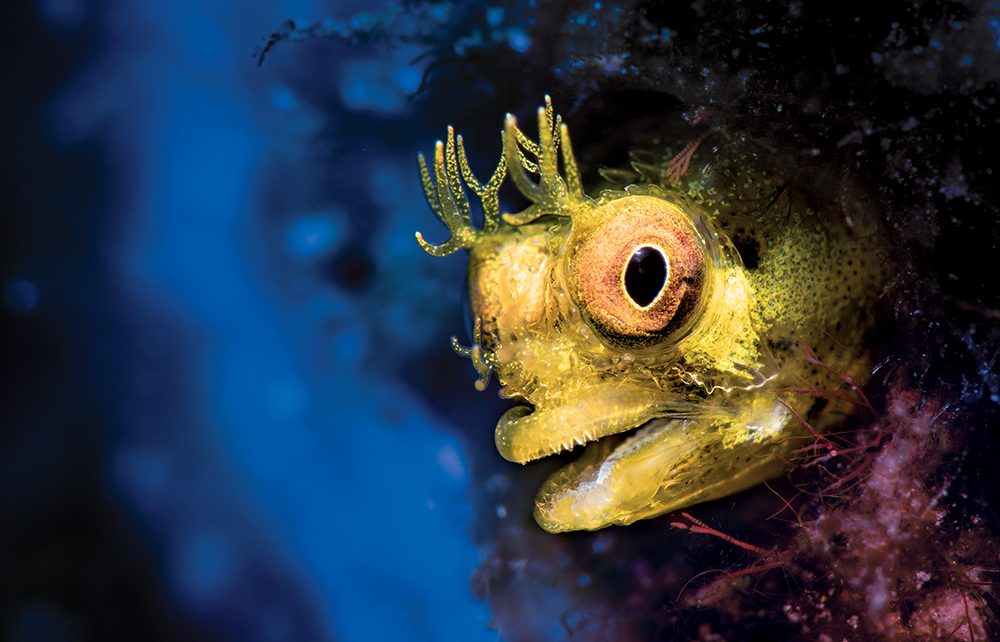
Blennies are incredibly charismatic and photogenic. I used a dive light with a blue gel filter to give the image a deep, rich texture in the background while snooting the blenny in the foreground. MIKE BARTICK
Did you find a market for the photos you were shooting back then?
I had a good relationship with California Diving News, so I asked them if I could write a travel feature. Their editor told me, “We love your photography, but if you want to be a writer, you have to practice every day.” The writing was never as easy as photography, but I wrote every day and recognized that being able to package words and photos was important.
Living nine months of the year in Anilao, Philippines, and being a partner and operations supervisor at Crystal Blue Resort seems a long way from recreational diving in Lembeh.
I raved so much about how good Lembeh was that one of my friends told me to try Anilao for a change of pace. It was 2007, and there weren’t a lot of international divers going there yet, but it was remarkably accessible. The ease of travel was promising. Then I went diving and was blown away. The wide-angle and macro opportunities were off the charts!
My catering business in California was going well, but the more it grew, the more I was stressed and wanted to be underwater. Diving and photography were cathartic, and I kept coming back to Anilao in my mind. What if I could build a comfortable resort with a dedicated camera room, great food, and world-class guides, like the resorts I’d enjoyed in Lembeh? I wanted to create that kind of operation in the Philippines but needed the right ingredients to come together.
In 2010 it all fell into place. The Philippines Department of Tourism sent me on a junket to dive around the country, during which I met my girlfriend. The emotional and professional ties were growing, then I stumbled upon Crystal Blue, an already-charming leisure resort with a modest dive concession. Anilao was a diamond in the rough, but I saw the potential.
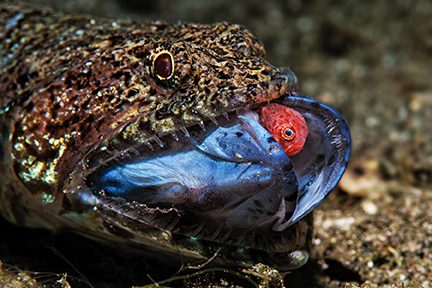
A lizardfish snatched a damselfish right in front of me, and as I was shooting, I noticed something red in the frame. I peered over my housing and saw a smaller fish being pushed out of the damsel’s mouth as the lizardfish consumed it. Big fish eats little fish; bigger fish eats big fish!
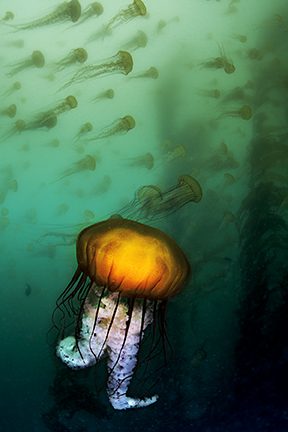
Huge blooms of sea nettles occur off the coast of Monterey, California. Known for its cold, emerald-green water, Monterey can be a challenging yet highly rewarding setting for photography.
MIKE BARTICK
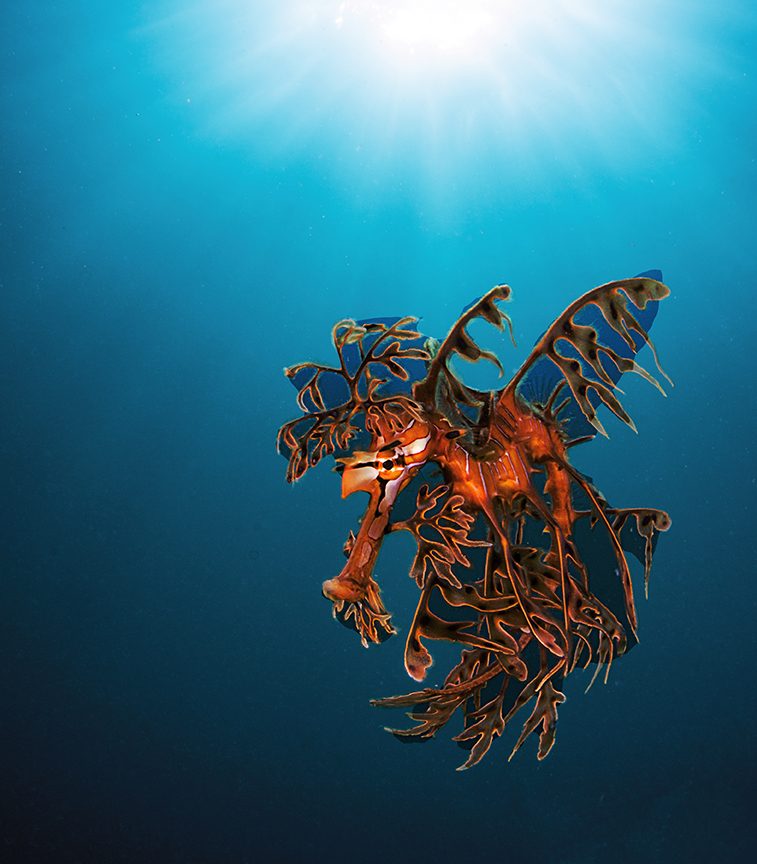
Leafy Seadragon. Adelaide, South Australia (Above left)
To my surprise, leafy seadragons are quite large, but I was prepared for this shot. When the moment came, I metered the sun, positioned my camera low, and framed it to utilize my position and the available light. Both luck and opportunity were on my side.
MIKE BARTICK
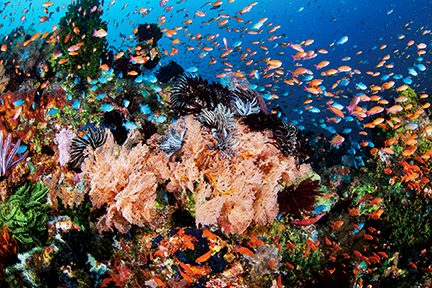
This site is incredibly energetic and full of life. It took three strobes to capture as much of the color and beauty as I possibly could in a single frame. Places like this leave me awestruck and wishing for a wider lens.
MIKE BARTICK
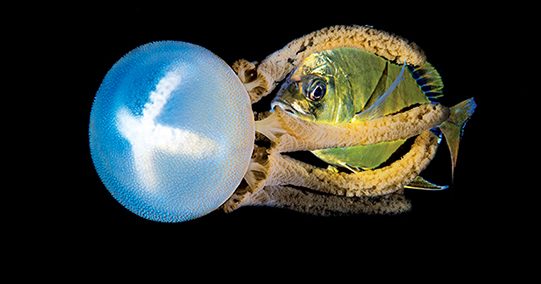
Blackwater diving offers incredible opportunities, such as this encounter with a cottonmouth jack and Thysanostoma jellyfish. Being tuned in to the moment is everything. MIKE BARTICK
Anilao is now known as a world-class dive destination, but I don’t remember that vibe from 2011. Were you involved in promoting it?
Yes, but kind of accidentally. I contacted a respected travel agent and told him what we were trying to do. He said Anilao was primarily known for “bad food, bad reefs, and bad air.” Clearly, we had some work to do if that was the perception. After we made some changes, our confidant sent a mystery shopper to the resort to evaluate our operation. The review was so glowing that we knew we were on the right track, and our business grew by word of mouth.
I’m guessing you aren’t still shooting that 3-megapixel Sony. What do you use these days?
I have the full-frame Nikon D850 and the cropped-sensor D500 and use whichever is best for the subject. I love shooting natural history, and I also began (as many of us do) with fish identification photos. But I wanted to go further toward an artistic execution, so I began to play with the lenses’ extremes and bokeh, variable shutter speeds, snoots, diopters, steel wool, and filtered lights. The underwater world of Anilao is an astonishing playground, and the diving was easy enough that I could experiment and improve.
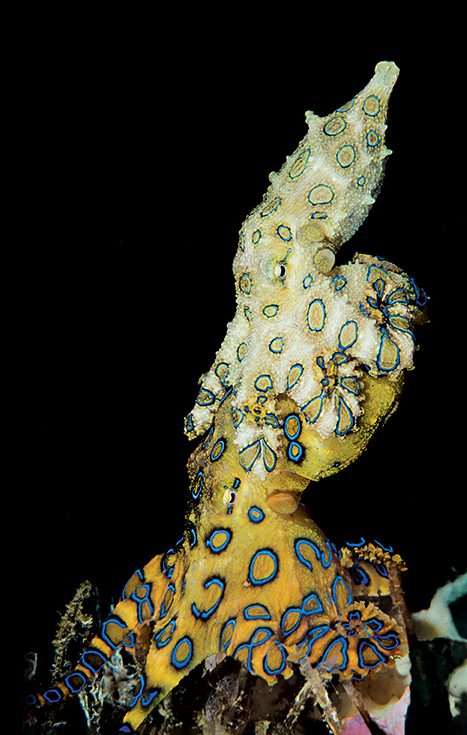
These mating blue-ringed octopuses were hanging from a beam in a wreck, so I framed this portrait with my 105mm macro lens while upside down.
MIKE BARTICK
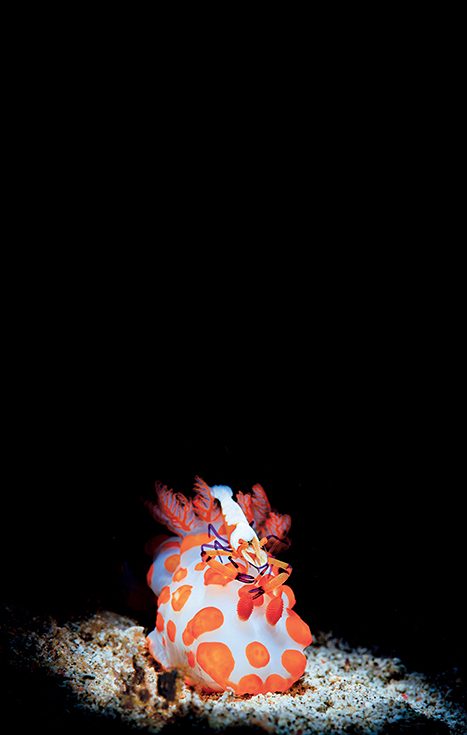
The beauty of subjects like this Gymnodoris sea slug and emperor shrimp speaks for itself. It’s up to me to capture the elements to the best of my ability.
MIKE BARTICK
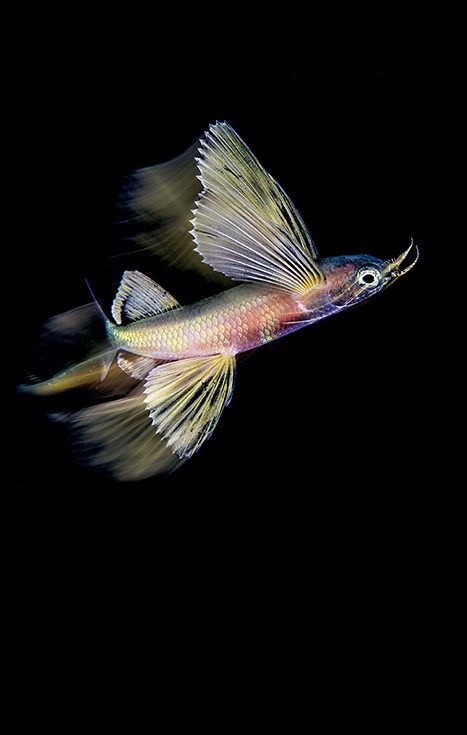
I used motion blur to capture the energy of a flying fish on the hunt. Understanding the technical aspects of lighting is a keystone element in creativity. Once you’ve grasped that, you’ll have a much broader range of what is possible.
MIKE BARTICK
You’ve shown the dive world a new universe of blackwater subjects from Anilao. How did it become the epicenter of blackwater diving?
Blackwater in Anilao started for me as bluewater in California. I was used to drifting in the open ocean and looking for subjects, so doing it at night seemed the next logical step. It wasn’t until I began seeing blackwater images from my buddy Gutsy Tuason that I got the real itch to do blackwater in Anilao.
In the beginning we would tie one end of a rope to the boat and the other end around a dive light and jump in. We explored every night, trying to find the best places and tinkering with our lights before we started to get results. Our first paper nautilus caught everyone’s eye, but the blanket octopuses, diamond squids, and settling wunderpuses are what put Anilao on the map.
I believe in mentoring new shooters. Helping them develop their eyes, skills, and knowledge, including ocean knowledge, and watching them go beyond what they think is possible is one of the best parts of my life. Mentors have helped me in so many ways, so I feel compelled to give back to the many who have never experienced blackwater or know how surreal marine life can be.
One good blackwater dive, and you’ll be hooked. It’s incredibly addictive, and if you’re like me in the slightest, it will alter your sleep patterns in no time. You’ll be staying up late and drifting under the stars. I love shooting everything from wide angle to macro, but when it comes down to it, blackwater diving is the ultimate in underwater photography. I consider myself just a guy with a camera who is lucky enough to be doing what he loves the most. AD
EXPLORE MORE
Learn more about Mike Bartick and his blackwater magic in this bonus online photo gallery and video.







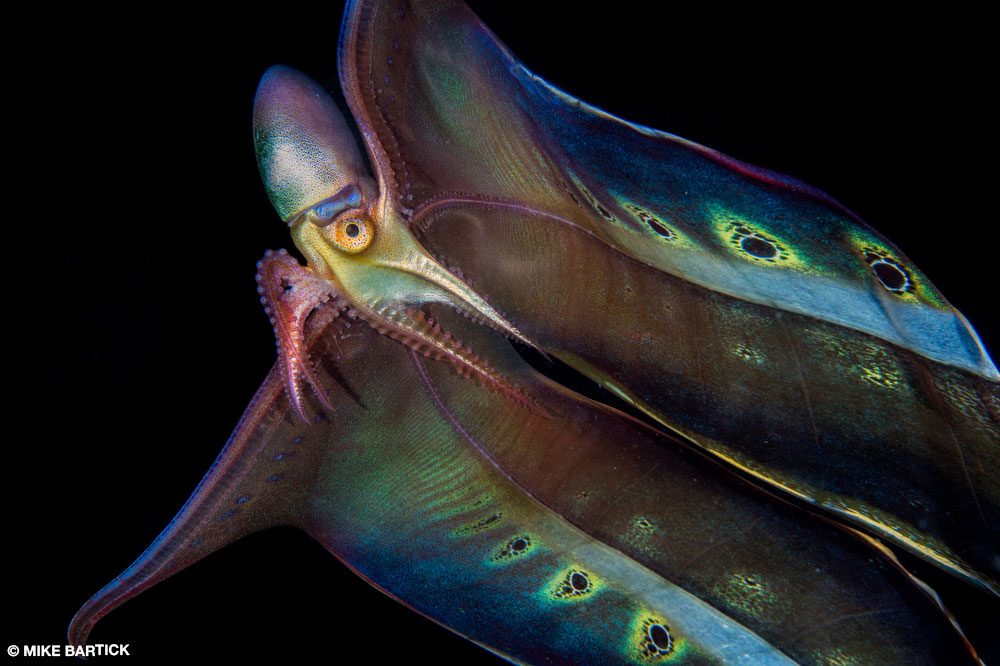







© Alert Diver — Q4 2022